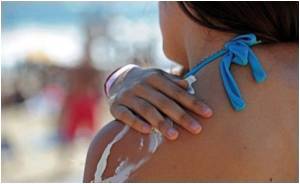Indoor tanning increases the risk for developing melanoma (the most lethal type of skin cancer), especially among individuals who start tanning at a young age.
Dr. Elliot J. Coups, from Rutgers Cancer Institute of New Jersey; Alan C. Geller, from Harvard School of Public Health; and Sherry Pagoto,from University of Massachusetts Medical School, who conduct research on tanning behaviors weigh in with their own 'Viewpoint' in the current online edition of
JAMA Dermatology about the FDA's guidelines on the use of tanning beds, including banning their use among individuals younger than 18 years.
Dr. Coups, a behavioral scientist at Rutgers Cancer Institute and an associate professor of medicine at Rutgers Robert Wood Johnson Medical School, is the lead and corresponding author of the commentary. He shares some insights about the proposed rule.
Q: What is the concern with this particular population and tanning bed use?A: Over the past several decades, tanning bed use, particularly among teen girls and young adult women has become a modern-day epidemic. More than 30 percent of non-Hispanic white girls ages 16 and 17 years report indoor tanning at least once in the past year (Guy G.P., et al.,
JAMA Dermatology, 2015). Indoor tanning increases the risk for developing melanoma (the most lethal type of skin cancer), especially among individuals who start tanning at a young age. Although melanoma is most commonly diagnosed among individuals over 60 years of age, it is the third most common cancer diagnosed among those aged 15 to 39 years (Keegan T.H.M., et al.,
Cancer, 2016).
Q: What would be the benefit of this proposed ruling should it go into effect?A: Prohibiting the use of indoor tanning devices among minors younger than 18 years is a much-needed step towards eliminating or reducing their use by teens and young adults. And while future research is needed to examine the impact of indoor tanning youth access restrictions on skin cancer outcomes and healthcare costs, we feel this effort will help toward reducing the estimated 419,000 cases of skin cancer caused by indoor tanning each year in the U.S. (Wehner M., et al.,
JAMA Dermatology, 2014).
Q: What are some concerns with this proposal?Advertisement
A: The proposal represents a landmark event in the regulation of indoor tanning devices. However, several concerns related to the proposal should be addressed in order to maximize its potential public health impact. The proposal only pertains to operators of facilities that charge a fee for using indoor tanning devices. It is unclear whether the proposal would cover gyms or other facilities that might offer tanning bed use as part of a membership or other fee. This is of concern because a recent study (Bulger A.L., et al.,
American Journal of Public Health, 2015) revealed that 41 percent of indoor tanners reported having ever tanned in locations other than traditional indoor tanning salons. Part of the proposal would require adult tanning bed users to sign a one-page risk acknowledgement every six months. We suggest that language be added to the risk acknowledgement to counter false claims commonly touted by the tanning industry regarding health benefits of indoor tanning (such as optimal production of vitamin D or reduced risk of certain cancers). Also, the impact of any ban that is enacted will depend on compliance with the ban and enforcement. An analysis of the first six states to enact tanning bans for minors revealed varying levels of enforcement. For example, while all of the statutes stipulated penalties for violations, only three states established tanning facility inspections and specified a particular department or agency for enforcement (Bulger A.L., et al.,
JAMA Dermatology, 2015).
Q: There are a number of states that have successfully enacted bans. Is this enough?Advertisement
A: It is encouraging to see that over the past four years alone we have seen successful legislative efforts banning indoor tanning for minors younger than 18 years in 13 states. In many of the remaining states, some restrictive measures are in place, however, they vary by age and parental consent, meaning the effort to protect U.S. minors is inconsistent. An FDA ban would equally protect all U.S. minors from the significant harms of tanning bed exposure. In 2014, the U.S. Surgeon General issued a Call to Action to Prevent Skin Cancer that highlighted the public health burden of skin cancer. One of the five goals outlined in the Call to Action was to reduce the harms of indoor tanning. The proposed new restrictions on indoor tanning put forth by the FDA represent a significant step in the right direction towards addressing this important public health goal.
Source-Newswise














